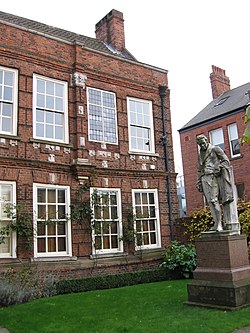Wilberforce House
| Wilberforce House | |
| Yorkshire East Riding | |
|---|---|
 Wilberforce House | |
| Location | |
| Grid reference: | TA10232886 |
| Location: | 53°44’40"N, 0°19’48"W |
| City: | Kingston upon Hull |
| History | |
| Address: | 178 High Street |
| Built Around 1656 | |
| For: | Lister family by William Catyln |
| Town house | |
| Information | |
Wilberforce House is a seventeenth century merchant’s house standing on High Street in Kingston upon Hull in the East Riding of Yorkshire, in part of the city known as the ‘Museums Quarter’. The house is the birthplace of William Wilberforce (1759–1833), the leading parliamentary campaigner for the abolition of slavery in the British Empire. It is a Grade I listed building.[1]
The house was built around 1656, probably by William Catyln for the Lister family. There was a phase of alterations around 1730 and the house was internally remodelled between 1755 and 1760. It was bought by Hull City Corporation in 1903, and opened as a museum in 1906.
Two other houses of interest on the High Street are Blaydes House and Maister House.
This was formerly a merchant's house with access to quayside on the River Hull.[2] Today the house is maintained as a museum, celebrating the life and work of William Wilberforce, of Hull's most famous sons.[3]
The front garden contains a statue of Wilberforce (which underwent a £10,000 restoration in 2011)[4] and which is itself a Grade II* listed structure.[5]
Adjoining the site are Oriel Chambers, the home of the University of Hull’s Wilberforce Institute for the Study of Slavery and Emancipation which conducts research into historic and contemporary forms of slavery.[6]
The house also exhibits the East Yorkshire Regimental collection.[7]
Outside links
| ("Wikimedia Commons" has material about Wilberforce House) |
- Wilberforce House Museum: Kingston upon Hull City Council
References
- ↑ National Heritage List 1209831: Wilberforce House Museum and Attached Garden Wall (Grade I listing)
- ↑ "Wilberforce House and Hull's High Street". Hull Museums. http://museumcollections.hullcc.gov.uk/collections/subtheme.php?irn=692.
- ↑ "Grant boost for work on anti-slavery museum". Yorkshire Post. 7 October 2005. https://www.yorkshirepost.co.uk/news/latest-news/grant-boost-for-work-on-anti-slavery-museum-1-2535042.
- ↑ "William Wilberforce statue in £10,000 restoration". BBC News Online (BBC). 12 June 2011. https://www.bbc.co.uk/news/uk-england-humber-13741632.
- ↑ National Heritage List 1197754: Statue of William Wilberforce in Garden of Wilberforce House (Grade II* listing)
- ↑ "Wilberforce Institute for the study of Slavery and Emancipation". WISE. University of Hull. 25 February 2011. http://www2.hull.ac.uk/fass/wise/about_us.aspx.
- ↑ "Wilberforce House Galleries". Hull City Council. https://www.hcandl.co.uk/museums-and-galleries/wilberforce-house/wilberforce-house-galleries.